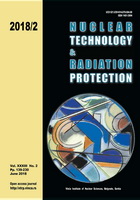
NATURAL RADIATION EXPOSURE AND RADON EXHALATION RATE OF BUILDING MATERIALS USED IN TURKEY

Vol.
XXXIII, No. 2, Pp. 139-230
June 2018
UDC 621.039+614.876:504.06
ISSN 1451-3994
Pages: 159-166
Authors: Seref Turhan, Alper T. Temirci, Asli Kurnaz, Aydan Altikulac, Elif Goren, Muhammet Karatasli, Rasit Kirisik, and Aybaba HancerliogullariAbstract
Measuring the natural radioactivity levels and radon exhalation rates (surface and mass) in building materials is essential to evaluate the extent of radiation exposure (external and internal) for residents in dwellings. Gamma-ray spectrometry with a high purity germanium detector was used to measure the activity concentrations of 226Ra, 232Th, and 40K in some building materials used in Turkey. Moreover, an active radon gas analyser with an accumulation container was used to measure their radon surface and mass exhalation rates. Results showed that the activity concentrations of 226Ra, 232Th, and 40K varied from 5.2 ± 0.6 (satin plaster) to 187.0 ± 2.4 (granite) Bqkg-1, 2.6 ± 0.8 (gypsum) to 172.2 ± 7.6 (granite) Bqkg-1 and 12.3 ± 17.0 (sand) to 1958.0 ± 83.4 (brick) Bqkg-1, respectively. Radon surface and mass exhalation rates varied from 2.9 (marble) to 2734.6 mBqm-2h-1 (granite) and 0.033 (marble) to 53.866 mBqkg-1h-1 (granite), respectively. The activity concentration index, indoor absorbed gamma dose rate and corresponding annual effective dose were estimated and compared with the recommended limit values. The results indicated that the building materials sampled presented no significant radiological risk.
Key words: natural radioactivity, radon exhalation rate, AlphaGUARD, annual effective dose,
building material
FULL PAPER IN PDF FORMAT (753 KB)